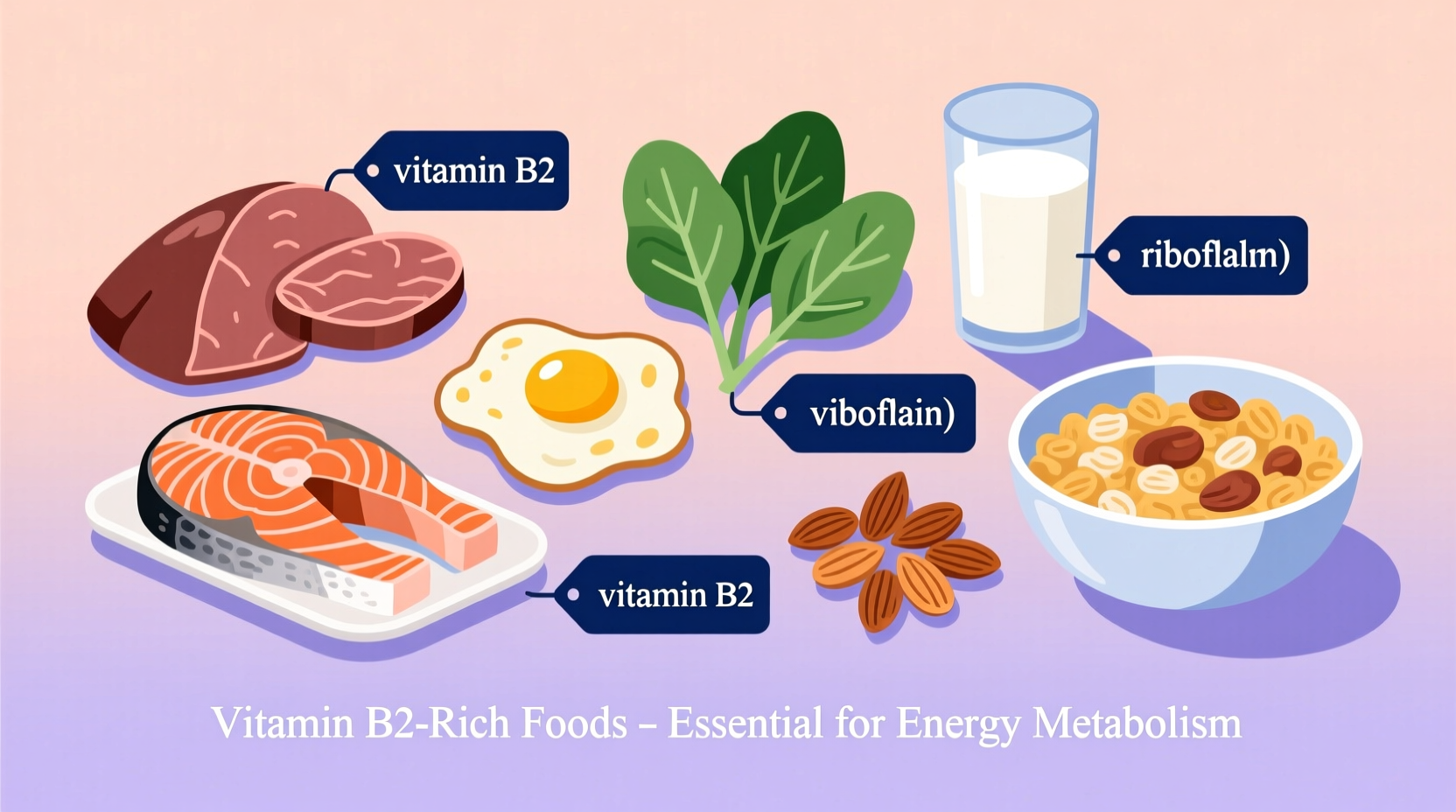The top food sources of Vitamin B2 (Riboflavin) include organ meats like liver (2.9 mg per 3 oz), dairy products such as milk (0.34 mg per cup) and yogurt, eggs (0.27 mg per large egg), almonds (1.05 mg per ounce), and fortified cereals (providing up to 100% of daily value per serving). These foods deliver substantial riboflavin that supports energy production, cellular function, and overall health.
Why Vitamin B2 Matters for Your Health
Vitamin B2, scientifically known as riboflavin, serves as a crucial coenzyme in your body's energy production system. According to the National Institutes of Health (NIH), riboflavin helps convert carbohydrates, fats, and proteins into usable energy through the electron transport chain. This essential vitamin also maintains healthy skin, eyes, and nervous system function while supporting red blood cell production.
Daily riboflavin requirements vary by age and gender. Adult men need 1.3 mg daily, while adult women require 1.1 mg, with higher needs during pregnancy (1.4 mg) and lactation (1.6 mg). These values come from the NIH's Office of Dietary Supplements, which establishes evidence-based nutrient recommendations.
Top Food Sources of Vitamin B2: What You Need to Know
Understanding which foods provide optimal riboflavin intake helps you make informed dietary choices. Let's explore the most potent sources across different food categories.
| Food Source | Serving Size | Riboflavin (mg) | % Daily Value |
|---|---|---|---|
| Beef liver | 3 ounces | 2.9 | 223% |
| Fortified breakfast cereal | 1 cup | 0.57-1.7 | 33-130% |
| Almonds | 1 ounce | 1.05 | 81% |
| Yogurt, plain | 1 cup | 0.6 | 46% |
| Eggs | 1 large | 0.27 | 21% |
| Spinach, cooked | 1/2 cup | 0.21 | 16% |
Data sourced from USDA FoodData Central (2023) provides these verified nutrient values. Notice how organ meats and fortified foods deliver the highest concentrations, while plant-based options like almonds offer substantial amounts for vegetarians.
Maximizing Your Riboflavin Intake
Riboflavin's water-soluble nature means proper food handling preserves its nutritional value. Unlike some vitamins, riboflavin remains stable during cooking but degrades when exposed to light. The NIH recommends storing milk and dairy products in opaque containers to prevent riboflavin degradation from light exposure.
For optimal absorption, pair riboflavin-rich foods with sources of other B vitamins. This synergistic approach enhances your body's ability to utilize these nutrients effectively. Consider these practical combinations:
- Morning meal: Fortified cereal with milk and sliced almonds
- Lunch option: Spinach salad with hard-boiled eggs and cheese
- Dinner suggestion: Beef liver with roasted asparagus (providing additional B vitamins)

Who Needs More Vitamin B2?
Certain populations require increased riboflavin intake. Athletes and highly active individuals often need more B vitamins to support their elevated energy metabolism. The Mayo Clinic notes that people with certain genetic variations affecting riboflavin metabolism may require higher intake levels.
Vegetarians and vegans should pay special attention to riboflavin sources since animal products contain the highest concentrations. Fortified plant milks, nutritional yeast, and almonds become particularly valuable in these dietary patterns. According to research published in the American Journal of Clinical Nutrition, vegetarians can meet their riboflavin needs through careful food selection and fortified products.
Recognizing Riboflavin Deficiency
While severe riboflavin deficiency is rare in developed countries, marginal deficiencies can occur. Common symptoms include:
- Cracks and sores around the mouth
- Inflamed tongue (glossitis)
- Skin inflammation
- Sensitivity to light
- Fatigue and weakness
The World Health Organization identifies riboflavin deficiency as a concern in populations with limited access to dairy and meat products. If you experience these symptoms persistently, consult a healthcare provider rather than self-diagnosing.
Practical Meal Planning for Optimal B2 Intake
Incorporating riboflavin-rich foods into your daily routine doesn't require drastic changes. Try these simple strategies:
- Start your day with fortified cereal and milk
- Add cheese to sandwiches and salads
- Include eggs in at least one meal daily
- Snack on almonds or other nuts
- Choose yogurt over regular snacks
For those following plant-based diets, nutritional yeast provides an excellent riboflavin source with approximately 0.5 mg per tablespoon. Many plant milks are also fortified with riboflavin, making them valuable alternatives to dairy.
Common Questions About Vitamin B2 Foods
Understanding riboflavin sources helps optimize your nutritional intake. Here are answers to frequently asked questions:











 浙公网安备
33010002000092号
浙公网安备
33010002000092号 浙B2-20120091-4
浙B2-20120091-4